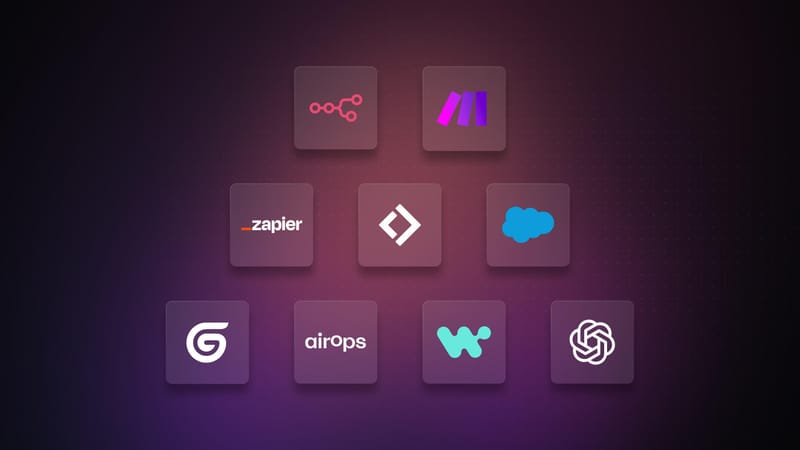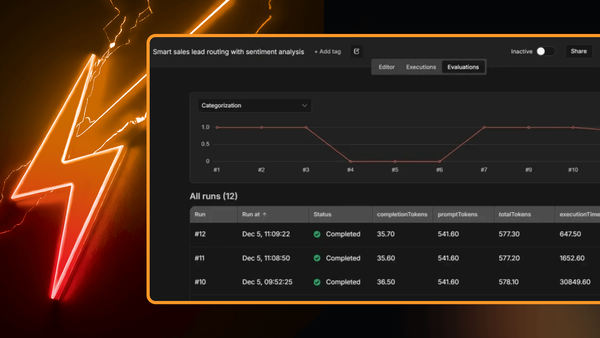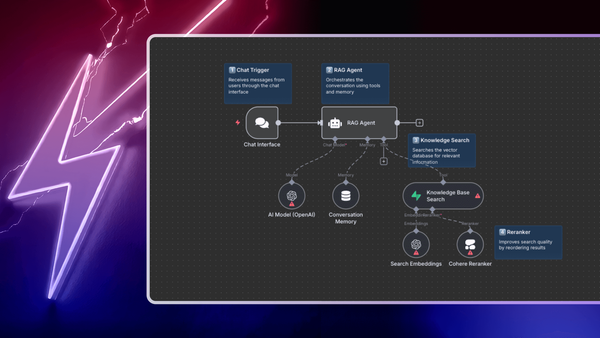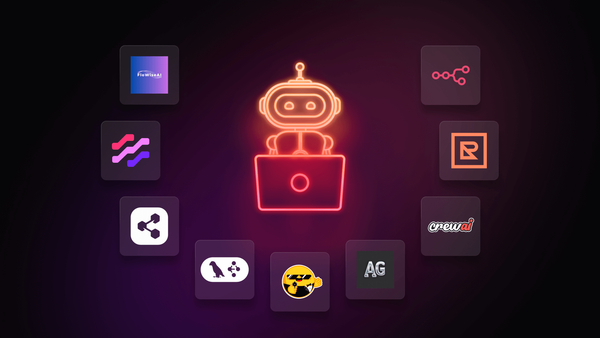Automating tasks has long been a proven strategy for enhancing efficiency. With the addition of AI, we can take productivity to an entirely new level.
Building a business and working with a team forced me to think through the logic of delegating tasks and building repeatable workflows. This foundation in process-driven thinking has proven invaluable as AI workflow tools have evolved — they enable me to use and expand upon the same logical approach that worked for delegation, powering sophisticated AI automations.
After experimenting with several AI automation tools, such as n8n, I’ve started to get a feel for what works well for different technical skill levels, business needs across sales, marketing, and operations, and varying business sizes, ranging from freelancers to enterprise teams. Let’s dig into the best AI workflow automation tools on the market in 2026.
What is an AI automation tool?
An AI automation tool combines the power of artificial intelligence with the standardization of automated workflows. Instead of just moving data from one app to another (traditional automation), an AI automation tool can interpret, decide, generate, and adapt as it runs. AI automation tools can also help you integrate with other third-party applications that power up your workflows.
A major benefit of incorporating AI with automation is intelligent handling of edge cases. With proper setup, AI workflows can gracefully manage unexpected scenarios — even those you haven't explicitly anticipated — whereas traditional programming requires you to predefine every possible path.
That said, the term “intelligence” in AI is somewhat of a misnomer. Rather than outsourcing reasoning completely, you can engineer AI workflows to set you up for success, then implement a “human-in-the-loop” (HITL) review of outputs before taking final actions.
How we selected the best AI workflow automation tools
With new AI automation tools emerging rapidly, it’s essential to establish clear criteria for evaluating quality.
Specifically, the AI automation tools on our list combine some (if not most) of the following key characteristics:
- Highly customizable/flexible: Even the more specialized tools on this list are flexible enough to suit workflows across different departments and needs. Some AI workflow automation platforms are more open, offering code fallback options (such as JavaScript and Python) and source-available licensing, making them ideal for developers who need deep customization. Others provide a more managed, closed environment that simplifies the experience but limits technical flexibility.
- Extensibility: Each option we’ve covered is extensible via connections to third-party tools and services. We’ve noted major limitations, as well as built-in integrations.
- Accessible pricing depending on the use case: Most AI workflow automation tools offer limited free plans that make it possible to do your own testing before committing, as well as reasonable monthly pricing that scales nicely and allows for budget-friendly access, whether you’re a freelancer or in-house team. However, some of the more enterprise-focused platforms come with steep price tags that make them unrealistic for smaller players. Ultimately, we’ve provided a range of options for effectively addressing varying needs.
- Good visual workflow design: While certain platforms are better suited for more technical users, an approachable user interface (UI) is a crucial foundation for building any AI automation workflow. Note that although all platforms mentioned have a learning curve, the steepness varies significantly.
- Enterprise-level security and compliance: Moving data and connecting external tools necessitates robust security, particularly for enterprise businesses with stringent compliance requirements. Platform requirements typically include SOC 2 compliance, secret management, and role-based access controls. Enterprise also brings with it a larger need for overarching workflow observability and monitoring.
- Technical scalability: Beyond just features, true scalability requires considering how workflows perform at scale, whether pricing remains reasonable as usage grows, and if the platform can handle increasingly complex automations without degradation. Tools built for different technical audiences will scale differently — a platform optimized for simplicity may hit walls that a more technical platform can push through.
With an understanding of these foundational criteria, let’s explore each of the best AI workflow automation tools in-depth.
The 9 best AI workflow automation tools of 2026
| Tool | Best for | Standout Features |
Pricing |
|---|---|---|---|
| n8n | All-around flexibility for technical + enterprise users |
Source-available, self-hosting, JS/Python steps |
Free self-hosted; Cloud from $20/mo |
| Zapier | Non-technical users connecting popular apps |
8,000+ integrations, beginner UI |
Free tier; Pro $19.99/mo |
| Make | Scenario building & data transformation |
Visual builder, detailed control |
Free tier; Core $9/mo |
| Gumloop | Simple no-code AI workflows |
Templates, MCP support |
Free tier; Solo $30/mo |
| Lindy.ai | Straightforward automations |
4,000+ integrations, AI voice |
Free tier; Pro $39.99/mo |
| Agentforce | Salesforce users | Deep SFDC integration, AI voice |
Flex credits from $500 |
| Workato | Enterprise automation | RBAC, governance, AIRO |
Enterprise only |
| AirOps | SEO + content | Semrush/Moz, Power Agents |
Free 1k tasks; Paid via sales |
| ChatGPT Agent Builder | OpenAI users | Built into UI, drag-and-drop |
Included in Plus ($20/mo) |
1. n8n for all-around flexibility and scalability for technical and enterprise users

Best for: Technical users and enterprise teams seeking ultimate flexibility and cost-effective scalability.
n8n key features:
n8n is getting a lot of buzz, and for good reason. In tandem with the AI assistant, the recently released AI workflow builder has made getting started easier than ever, alongside a robust user community that has contributed 4,000+ starter templates on n8n — with even more options available to import as JSON from GitHub. n8n offers several node options (workflow steps) that include both built-in integrations and the flexibility for custom code fallback via Python and JavaScript.
n8n isn’t the easiest tool on this list to use when getting started, but once you invest the time to learn it, it’s a powerful force multiplier. Taking Morten Rand-Hendriksen’s Build AI Agents and Automate Workflows with n8n course on LinkedIn Learning helped me speed through the learning curve and made the platform click for me. But it wasn’t until I rebuilt a workflow on n8n that I originally started on Zapier that I came to appreciate the flexibility and robust determinism that I can achieve with n8n’s nodes, especially when using the code steps.
Hands-on users will find the platform even more rewarding as they dive deeper. For example, after working with both the managed and self-hosted versions of n8n (including setups on DigitalOcean Droplets), I’ve found the fair-code AI workflow automation tool’s flexibility to be a major advantage.
I’ve even built multi-agent workflows for clients that generate social posts from relevant news items and utilize retrieval-augmented generation (RAG) to craft replies referencing specific podcast transcripts and URLs stored as metadata (see the screenshot in this section). This illustrates just how far you can push automation with n8n.
Here are some n8n workflow templates I’ve either tested myself or are next on my build list:
Enterprise users will appreciate the source-available code, SOC 2 compliance, secret-management via AWS/GCP/Azure/Vault, logging, debugging, and role-based access control (RBAC).
n8n is the only AI workflow automation tool on this list that offers a free self-hosted option for technical users to take advantage of. The cloud platform starts at $20/month (billed annually) for 2,500 workflow executions with unlimited steps, which is notably different than others listed that charge variable credits per step.
2. Zapier for non-technical users connecting popular apps
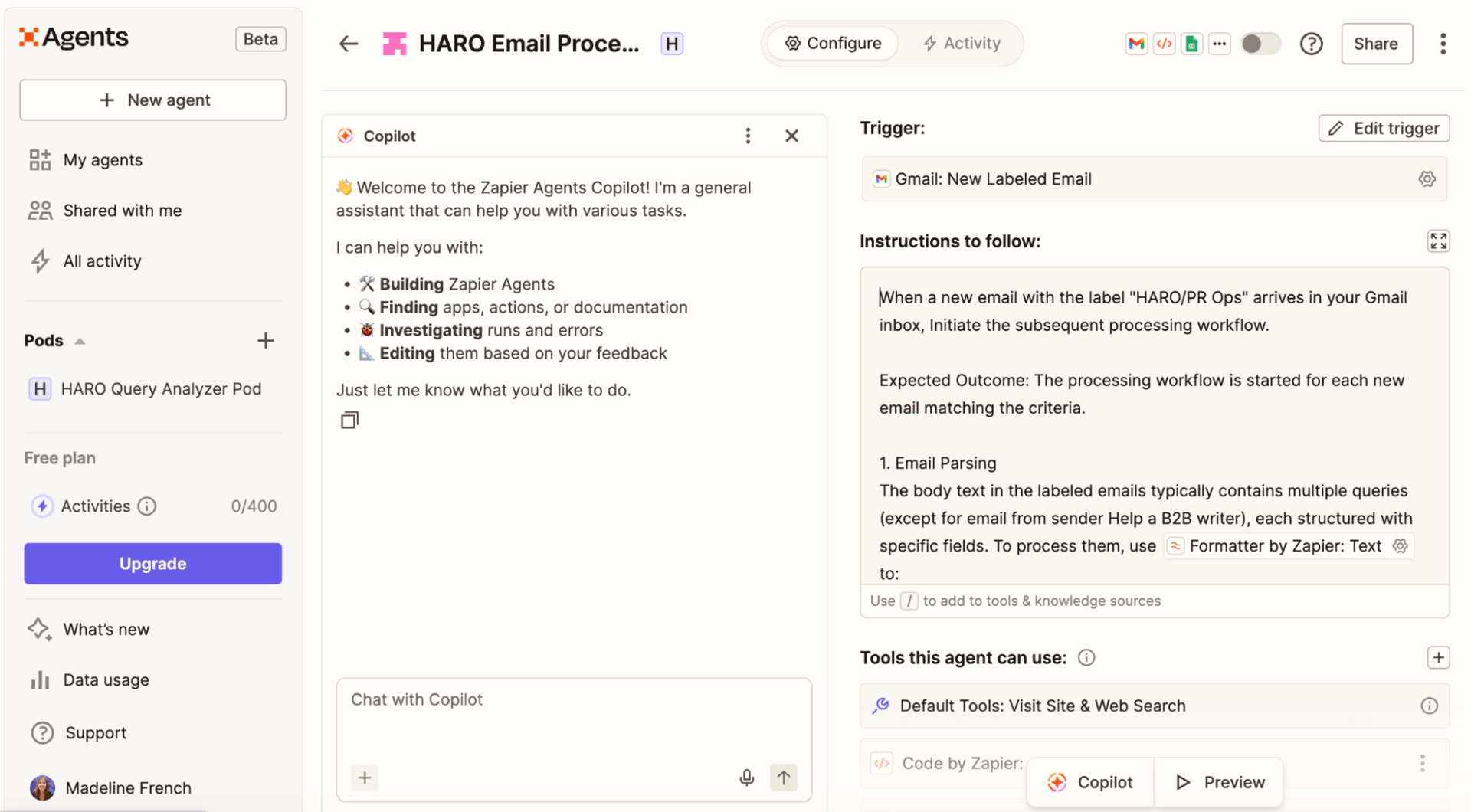
Best for: Beginners building straightforward workflows that connect to popular work apps.
Zapier key features:
Zapier is a user-friendly AI workflow automation tool designed for beginners and non-technical users. It’s most well-known as a workflow automation tool but has added a number of AI features across its platform, including Agents, AI automation steps, and MCP. To help users go from idea to execution, Zapier offers an AI copilot for building across each tool, as well as starter templates for each product. Notably, Zapier offers 8000+ built-in integrations with popular work apps (the most on this list), as well as some flexibility to add code steps and integrate third-party APIs.
Zapier shines as a simple no-code platform for building functional apps (thanks to features like Interfaces and Tables). The UI is very approachable, making it a strong contender for teams that want to build AI automations but lack budget or access to developer support.
While these users benefit from the managed experience, technical teams may find it less flexible than other popular options for their needs. For instance, although connected apps are managed centrally, custom API connections and secrets must be configured individually for each workflow, rather than being reused across automations. This can impact both efficiency and security governance for enterprise implementations.
I often use Zapier when I start building out the logic for a workflow. I find their customer support to be top-notch; however, there have been times when I’ve had to abandon workflows I’ve spent hours on, even after customer support has intervened. It’s frustrating to invest so much time and still end up without a workable solution.
Zapier separates pricing for AI Orchestration (which includes their Zaps (automations), MCP, Tables, and Interfaces products), Agents, and Chatbots — the latter two options are available as add-ons to AI Orchestration plans. AI workflow automation free options include AI Orchestration Free includes 100 tasks/month, Agents Free includes 400 activities/month, and Chatbots Free includes 2 chatbots.
The AI Orchestration Professional starts at $19.99/month (billed annually) and includes 750 tasks per month, as well as additional features such as multi-step Zaps, webhooks, and email and chat support. Agents Pro starts at $33.33/month (billed annually) and includes 1500 activities. Chatbots Pro starts at $13.33/month (billed annually) and consists of 5 chatbots, as well as additional features such as an expanded knowledge base and 100k Table records.
3. Make for scenario building and powerful data transformation
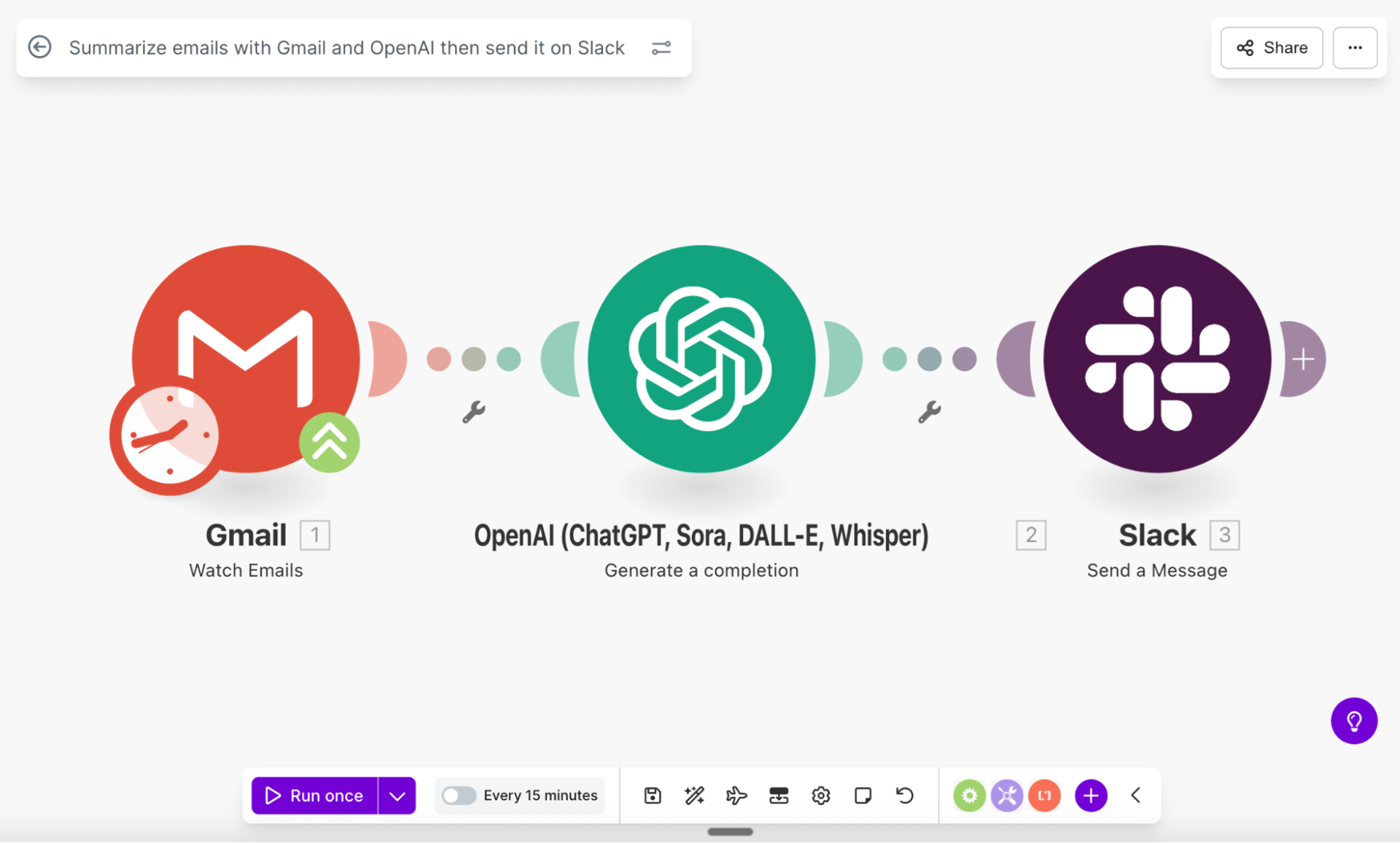
Best for: Technical teams with automation experts.
Make key features:
Make is often compared to Zapier — the differences between these AI automation tools are nuanced. Like Zapier, it offers tools for building automations with AI, as well as an AI agent feature. Enterprise users will appreciate the “Grid” for AI orchestration, which provides a high-level view of a brand’s agents, apps, and workflows, aiding in observability, improving performance, and simplifying debugging. Like Zapier, secret management is not comprehensive, and it’s also worth noting that Make offers limited role-based access control.
As with many other options on this list, there are several built-in integrations, including multiple AI models, pre-built workflow templates, and an MCP server option. The UI is relatively clean and straightforward, but this perceived ease of use may cause a false sense of security. Make notably involves more setup than some of the more beginner-friendly options shared here.
Make offers a limited Free plan that includes 1,000 credits/month. Paid plans, which start at $9/month (billed annually) for Core, include 10,000 credits/month and features such as unlimited active scenarios (automations), increased data transfer limits, and access to the Make API. Notably, when paid annually, the total credits for the year are available immediately for use, not limited by month. It’s worth noting that you must pay (use credits) for each step in a workflow, including error handling. Some steps consume more than one credit (especially AI steps), so scaling should include focusing on how to optimize costs.
4. Gumloop for simple no-code and niche AI workflows

Best for: Technical users with niche needs in target industries (sales, marketing, operations, support, engineering).
Gumloop key features:
You’ll find it either refreshing or limiting that Gumloop, as a platform, is the newest company on this list of the best AI workflow automation tools. But what it lacks in tenure, it makes up for in robust niche use cases.
Gumloop offers a number of useful resources for new users, including templates, a self-paced course and guided learning cohort, a Chrome extension for building, MCP, and its AI building assistant, “Gummie.” It’s clear that Gumloop does a lot to educate users, but in my experience, it’s not quite intuitive — even with extensive user guidance. In fact, even after watching some of their educational videos, I found the UI to be a bit cluttered and overwhelming, as well as difficult to navigate via keyboard and mouse without taking undesired actions.
Compared to other options on this list, the scope of use cases is narrower, as are the built-in integrations (100+); however, there are options to add custom integrations and APIs.
Gumloop’s Free plan includes 24,000 credits/year. The Solo plan starts at $30/month (billed annually), which includes 120,000 credits/year, plus unlimited triggers, 4 concurrent runs, email support, webhooks, and the ability to bring your own API keys.
As with Make, Gumloop’s variable credit system, based on workflow complexity, can make it difficult to predict costs.
5. Lindy.ai for common and straightforward workflow automations
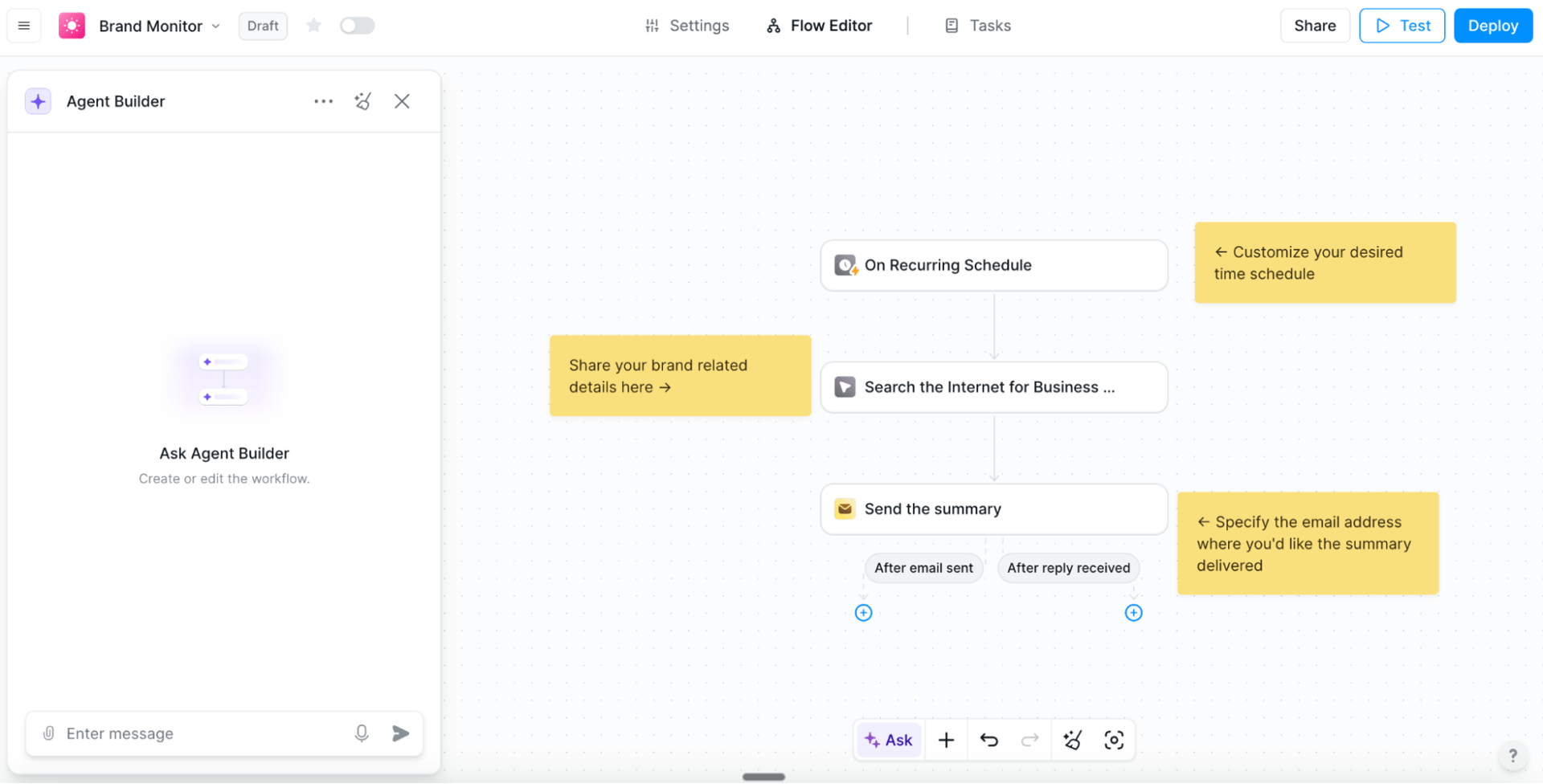
Best for: Lightweight business automations with common work apps — especially email, meeting, and sales tasks.
Lindy.ai key features:
Lindy.ai is not the most robust or extensible AI workflow automation tool. Still, it’s a favorite of many users precisely because it’s uncomplicated — especially those in tech, finance, real estate, and healthcare. It integrates with many of the most widely used business apps (100 in the Free Plan, 4,000+ on paid plans) and makes it easy for new users to get started with a library of pre-built templates. It notably offers AI voice features and a HIPAA-compliant healthcare notetaker. Check out Lindy.ai’s community for ideas and support.
Lindy.ai provides a straightforward approach to getting started with building simple AI workflows using connected tools. But the simplicity can be a double-edged sword — it’s not particularly suitable for advanced or custom workflows. Lindy’s own literature mentions that it’s not particularly strong for non-AI integrations. For enterprise users, there’s no secret management and role-based access control, and its simplistic nature also means there are no custom code fallback options.
I used a template to set up a simple brand monitoring agent on Lindy.ai, but the outputs weren’t super useful — Lindy.ai surfaced outdated information for a workflow that’s supposed to run regularly to stay on top of timely news.
Lindy.ai’s Free plan includes 400 credits per month (up to 40 tasks), with limited integrations. Pro starts at $39.99/month (billed annually), and offers 5,000 credits per month, 1,500 tasks, 30 phone calls, and 4,000+ integrations.
6. Agentforce for Salesforce users and sales use cases

Best for: Salesforce users who want to build AI automations with integrated data.
Agentforce key features:
Agentforce is a niche AI workflow automation tool that builds on data and features provided in the Salesforce platform. Like other options on this list, it offers MCP support and pre-built agent templates. Notably, it includes functionality for multi-agent orchestration. Similar to Lindy.ai, it also provides built-in functionality for AI voice agents.
It's worth noting Salesforce's positioning around AI agents, particularly given their recent organizational changes and their own research findings. A Salesforce-led study revealed that multi-step agents frequently struggle to complete objectives reliably, which provides useful context for evaluating any agent-based platforms (including Salesforce’s) promises.
Agentforce leans more towards enterprise in terms of features and pricing. Generally speaking, Flex Credits (pay-per-action) start at $500 for 100,000 credits. Conversations start at $2 per conversation. Using Agentforce makes the most sense for existing Salesforce enterprise users.
7. Workato for enterprise marketing and sales tasks
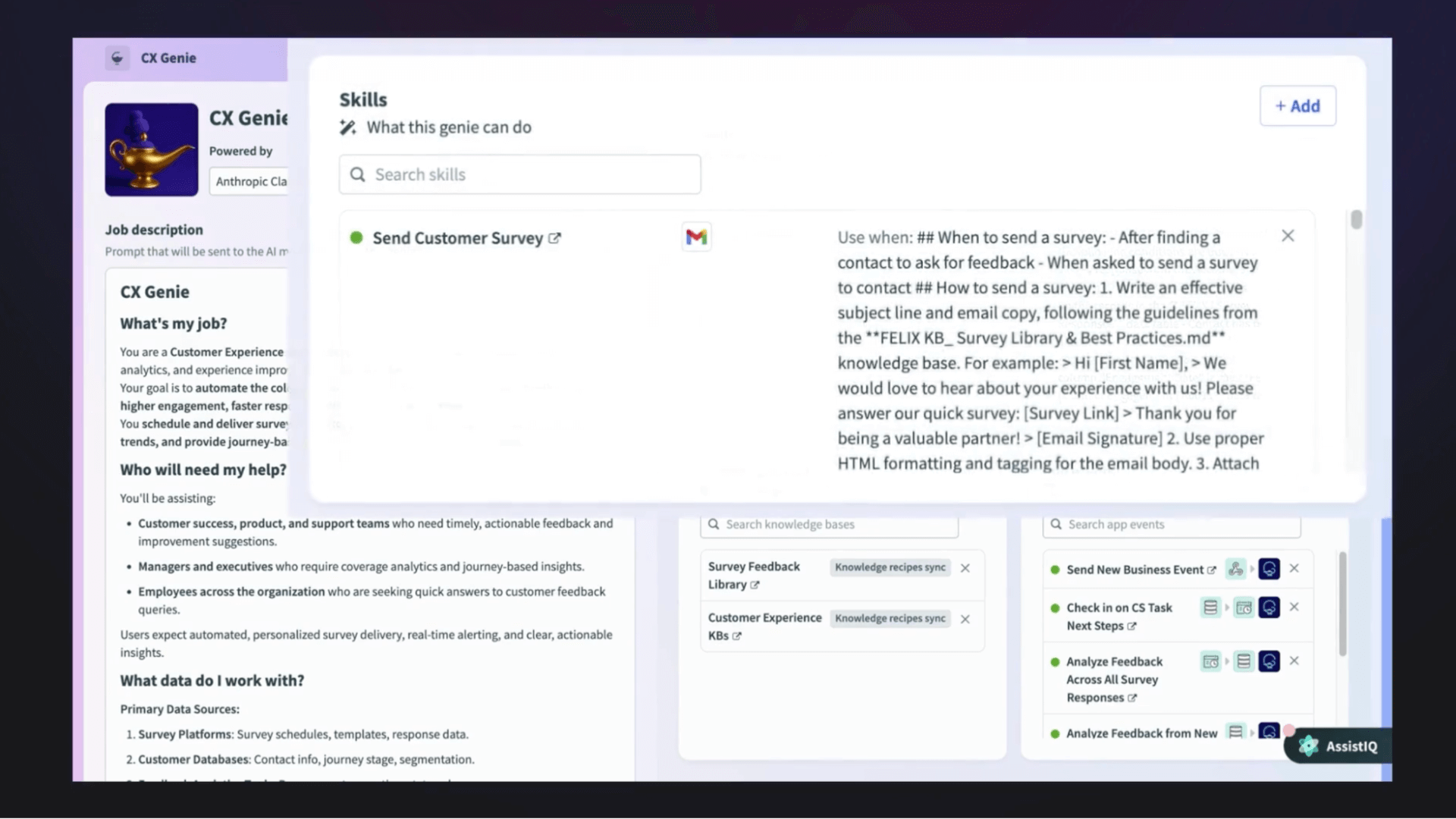
Best for:IT professionals building integrations for enterprise sales and marketing teams.
Workato key features:
Workato is a powerful workflow automation tool for cross-departmental use cases, featuring several useful AI-driven features. It integrates with 1200+ apps, offers MCP functionality, an Agent Library with prebuilt agents (called “Genies”), and their AI copilot for workflow building (“AIRO”). It’s especially ideal for enterprise users requiring SOC 2 Type II compliance, comprehensive role-based access control, centralized governance dashboards, and guaranteed SLAs for uptime and support.
Like Agentforce, Workato is a powerful AI workflow automation tool for enterprise and niche use cases. It requires more technical resources to set up properly, which could cause bottlenecks when actual users require updates. Because it’s completely proprietary, there’s also limited inline code customization and no source-available licensing.
Workato doesn’t publicly publish its pricing, prompting interested parties to contact sales — but note that it’s an enterprise tool, so pricing will start significantly higher than that of many other options on this list. Pricing is a factor of tasks, the use of advanced connectors, and the number of users on an account.
8. AirOps for specialized SEO and content marketing workflows
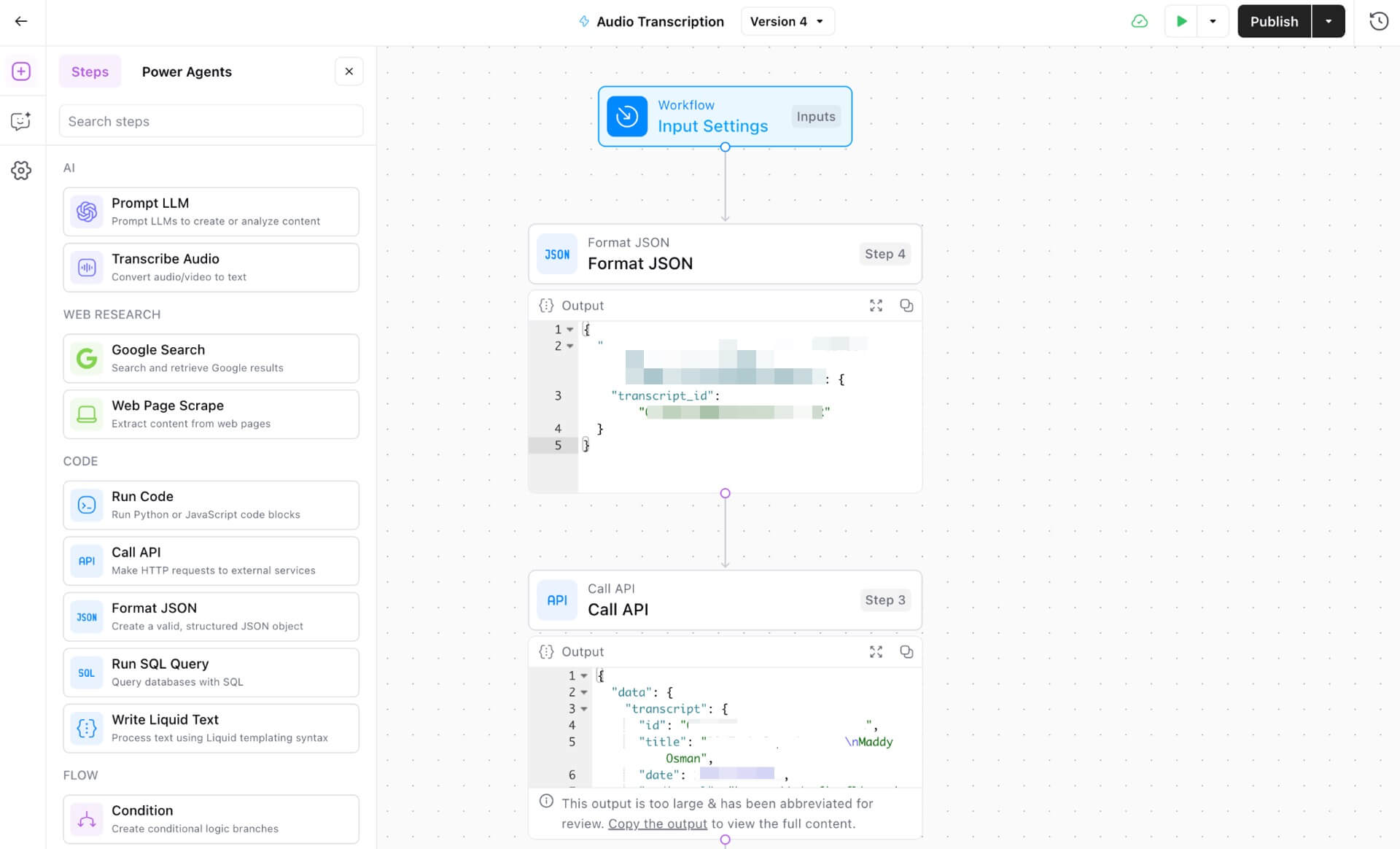
Best for: Technical SEOs and content marketers.
AirOps key features:
AirOps is an emerging AI workflow automation tool designed for a specialized audience of content marketers/SEOs who require access to industry-standard data connectors, such as Semrush and Moz, as well as integrations with popular workflow tools like Slack, Google Docs, and content management systems (CMSes) like WordPress. It offers the flexibility to add custom code steps and your own API keys, which I used when creating a workflow that transformed transcript data originating from my AI notetaker, Fireflies.ai (see screenshot).
AirOps invests a significant amount of resources in building community and educational content, including live cohorts and the self-paced AirOps University course. I’m a fan of their many prebuilt steps and Power Agents, which serve as useful templates for common content marketing/SEO workflows — there’s no need to start from scratch. Like many other options shared here, they offer an AI builder copilot. Notably, in line with its niche focus, AirOps also offers a knowledge base and brand kit features for customizing outputs in a useful way.
Compared to some of the beginner-friendly options on this list, AirOps comes with a learning curve and can be complicated to use. Though custom integrations are possible, there are limited built-in integrations. It’s also not necessarily built for enterprise-grade security and offers limited role-based access control.
AirOps offers a limited Free plan that includes 1,000 tasks/month. Pricing for paid plans with additional tasks and data integrations requires talking to sales, but you can test paid features with a free trial.
9. ChatGPT Agent Builder for OpenAI enthusiasts and existing subscribers
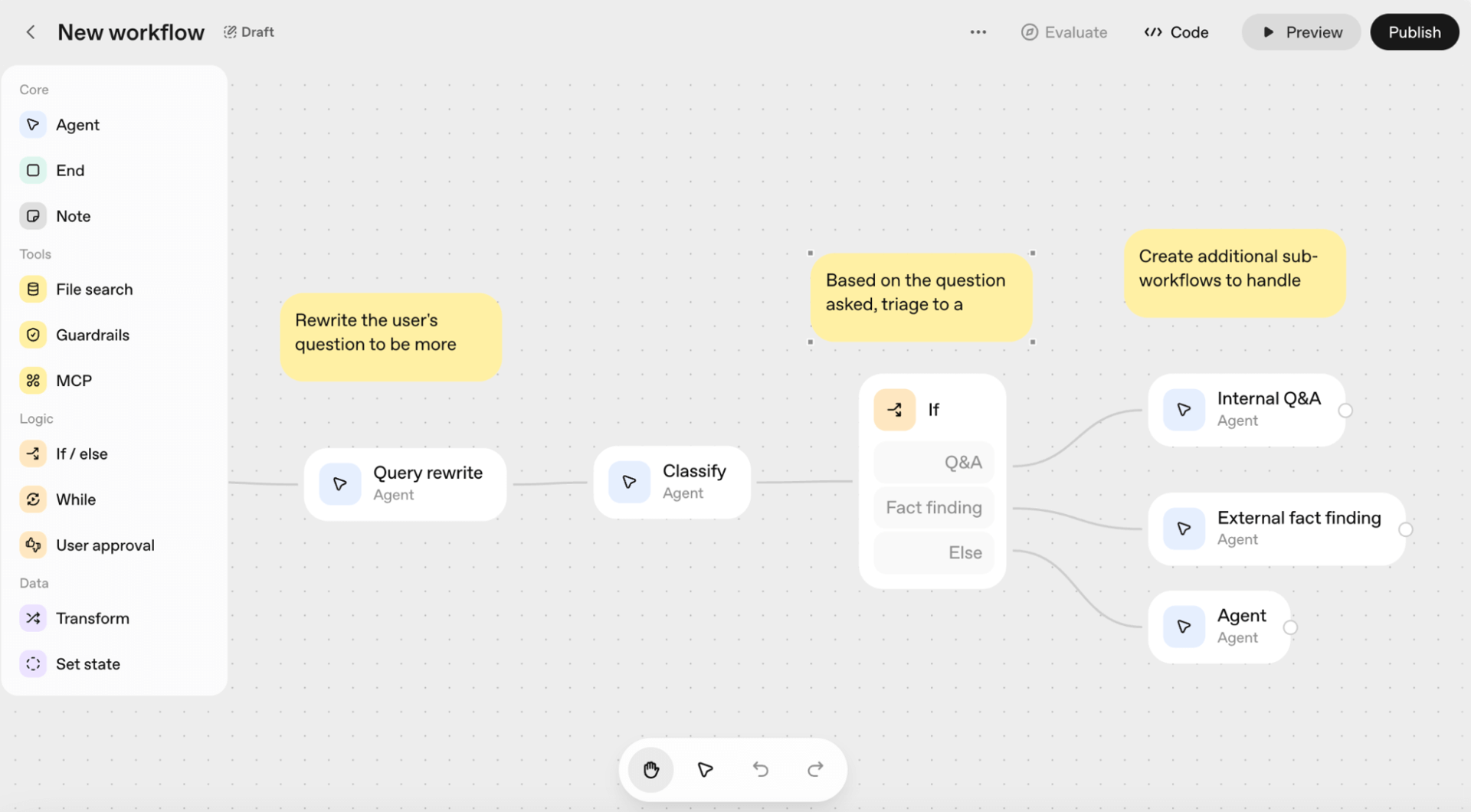
Best for:
Existing ChatGPT Plus/Pro subscribers and teams already invested in the OpenAI ecosystem.
ChatGPT Agent Builder key features:
ChatGPT Agent Builder is one of the newest options on this list, offering additional value and functionality for existing ChatGPT users. The drag-and-drop user interface looks fairly straightforward, though it’s more technical and complicated to use than it appears at first glance. However, unlike the other options on this list, no separate infrastructure is required to get started.
ChatGPT Agent Builder offers exciting possibilities, but its first iteration is somewhat limited and clunky to use compared to some of the more beginner-friendly platforms. Although I consider myself an intermediate to advanced user of many of the AI workflow software on this list, I still couldn’t quite grasp how to get started with ChatGPT Agent Builder, even after watching a walkthrough on LinkedIn Learning.
Note that you’re limited to OpenAI models and their strengths. Also, it doesn’t (currently) offer triggers or scheduling, and the outputs are less deterministic than many other options on this list. The MCP is limited to built-in connectors without third-party options. It’s not the best choice for enterprises, as it offers limited security, governance, and compliance features.
ChatGPT Agent Builder pricing:
Unlike other options on this list, ChatGPT Agent Builder is not available for free but is included with paid ChatGPT plans, starting at Plus ($20/month). If you’re already a paid subscriber of ChatGPT, it offers built-in value without the need for additional investments in tools.
Explore 5 high-impact AI workflow automation tools examples with n8n
Get started with n8n with our library of more than 4,000 pre-built expert templates. Here are some top picks that span popular tools and use cases:
RAG Chatbot for Company Documents using Google Drive and Gemini
Get started with RAG (retrieval augmented generation), a technique for grounding AI results in reality. This n8n template uses Google Drive as a knowledge base for responses.
Voice-Based Appointment Booking System with ElevenLabs AI and Cal.com
Build an AI voice agent for booking customer appointments. This n8n template uses ElevenLabs voices with a Cal.com scheduler.
Extract and Analyze Google AI Overviews with LLM for SEO Recommendations
Create a vibe marketing workflow to help make progress with your GEO (generative engine optimization) approach. This n8n workflow extracts details about Google AI Overviews for target keywords and generates strategic recommendations.
Automate Social Media Posts with AI Content and Images across Twitter, LinkedIn & Facebook
Take the guesswork out of what to post next on your social channels. This n8n template connects with OpenAI to generate posts, saves a record in Google Sheets, and posts automatically to social media platforms.
Scrape recent news about a company before a call
Augment your sales process with intelligent data about the prospects you’re planning to meet with. This n8n workflow scans your calendar for meetings, uses newsapi.org to fetch relevant news, then delivers insights for your reference via Gmail.
AI workflow automation tools: FAQs
What is the most customizable AI automation tool?
n8n tops the list as the most flexible option, offering source-available code, custom JavaScript and Python code steps, and the ability to self-host. While tools like Zapier, Make, and Lindy are more closed down and abstract complexity behind the scenes — making them suitable for beginners — they lack the deep customization needed for advanced workflows.
For all-around needs and ultimate flexibility, choose n8n. If you're looking for niche tools, check out Gumloop, Agentforce, AirOps, and Workato.
What vendor provides the most extensible AI automation platform?
n8n leads in extensibility with custom coding options in addition to preconfigured nodes for major integration partners. Zapier offers the most pre-built connectors (8000+), but is more closed down. Most other tools on this list offer a mix of limited integrations alongside varying degrees of customization features.
Who offers the best pricing for AI-powered workflow tools?
n8n is the only tool that offers a free self-hosting option. Paid cloud plans start at $20/month for 2,500 workflow executions with unlimited steps — notably different from variable credit-based pricing. Most tools on this list offer limited free plans, though ChatGPT Agent Builder requires a paid subscription.
Workato and Agentforce are priced for enterprise, with significantly higher costs. n8n and Zapier charge by workflow execution, while others charge by workflow steps, which can make budgeting challenging as costs scale unpredictably.
What platforms support visual workflow design using AI?
All tools on this list offer some level of visual workflow design, with n8n, Zapier, Make, Lindy, and Gumloop being the most approachable. Rather than hopping between platforms to leverage different strengths, you're better off choosing a tool flexible enough to handle both simple and advanced workflows — this avoids the overhead of learning multiple platforms and UIs.
What is the most flexible AI automation solution for developers?
n8n is the clear choice for developers because it offers real code fallback in JavaScript and Python in addition to preconfigured integration nodes, plus source-available licensing. Unlike closed systems like Agentforce, n8n gives developers the freedom to customize at any level they need.
What is the most secure AI workflow automation platform?
Workato stands out for enterprise security with SOC 2 Type II compliance, comprehensive RBAC, centralized governance, and guaranteed SLAs. n8n also offers strong security features, including SOC 2 compliance, source-available code for auditing, secret management via AWS/GCP/Azure/Vault, and enterprise-grade RBAC.
What is the best AI workflow automation tool for enterprise teams?
Workato is purpose-built for enterprise with robust security, compliance, and governance features. However, n8n is also an excellent choice for enterprise teams, offering the security features enterprises require while providing superior flexibility for cross-departmental workflows. Most tools on this list offer enterprise tiers, but features vary significantly.
Who provides the best scalable AI automation for technical teams?
n8n and Workato both provide excellent scalability for technical teams, though Workato has a more narrow focus on sales and marketing use cases. n8n's combination of technical flexibility, execution-based pricing (vs. credit-per-step), and source-available code makes it ideal for technical teams building complex, scalable automations.
Wrap up
There are numerous AI workflow automation tools available on the market, catering to a wide range of specialty use cases, business types, and business sizes.
n8n offers the most flexibility, while Make, Zapier, Gumloop, and Lindy are good options for beginners and non-technical users seeking a more managed experience. AirOps, Workato, and Agentforce offer specialized solutions for sales and marketing needs, while ChatGPT Agent Builder is an exciting new option for existing ChatGPT paid subscribers.
Picking the right tool for your needs comes down to just a few factors:
- Your level of technical expertise and genuine interest in learning new technologies.
- The specific tools you want to integrate and the amount of effort you’re willing to put forth for the ideal setup.
- The nature of your workflows and desired flexibility, as well as non-negotiable security and compliance features.
- Your industry and the importance of using a tool tailored specifically for it.
But most importantly: just get started! The best way to understand which tool fits your needs is hands-on experience.
Beyond each platform's native resources, explore third-party courses (like LinkedIn Learning's n8n course by Morten Rand-Hendriksen), join communities where builders share workflows and insights (such as Lenny's Community, which has an n8n partnership), and connect with fellow AI enthusiasts on LinkedIn or in tool-specific Slack channels. Sharing what you're building not only accelerates learning but often leads to unexpected opportunities and collaborations.
Try n8n for free and experience the difference in automation.

